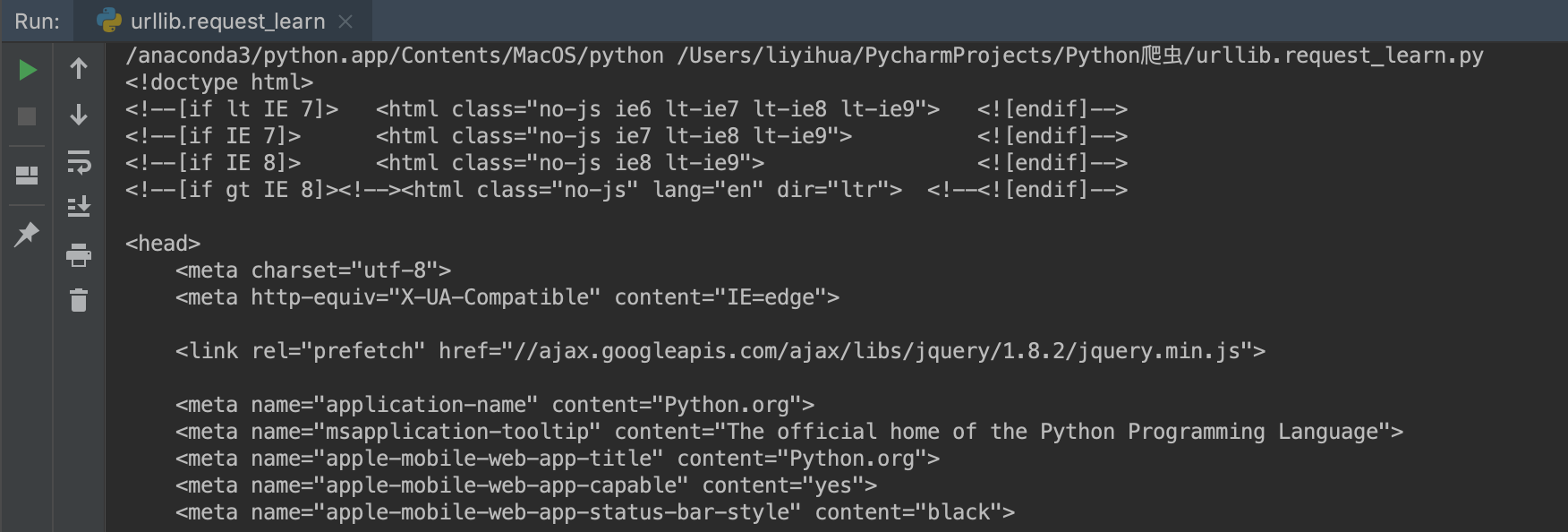urllib的简单使用
urllib模块是Python内置的HTTP请求模块
urllib包含模块:request模块、error模块、parse模块、robotparser模块
例子
举例1:
-
向指定的url发送请求,并返回服务器响应的类文件对象
response = urllib.request.urlopen('https://www.python.org') -
读取文件全部内容
html = response.read() -
将其他编码的字符串转换成unicode编码
print(html.decode('utf-8'))部分输出如下:

举例2:
-
向指定的url发送请求,并返回服务器响应的类文件对象
response = urllib.request.urlopen('https://www.python.org') -
输出
print(type(response)) -
输出结果如下
<class 'http.client.HTTPResponse'>
举例3:
import urllib.request
response = urllib.request.urlopen('https://www.python.org')
print(response.getheaders())
print(response.getheader('Server'))
说明:
# status属性:返回响应的状态码,如200代表请求成功
# getheaders()方法:返回响应的头信息
# getheader('name')方法:获取响应头中的name值
urllib子模块之Request模块
urlopen()方法可以实现最基本请求的发起,Request更强大
举例
import urllib.request
request = urllib.request.Request('https://python.org')
response = urllib.request.urlopen(request)
print(response.read().decode('utf-8'))
urllib.request.Request() 方法说明
Request(url, data=None, headers={ }, origin_req_host=None, unverifiable=False, mothod=None)
参数:
url参数: 请求URL
data参数:Post 提交的数据, 默认为 None ,当 data 不为 None 时,urlopen() 提交方式为 Post
headers参数:也就是请求头,headers参数可以在构造请求时使用,也可以用add_header()方法来添加
请求头最常用的用法:修改User-Agent来伪装浏览器(如伪装Firefox:
Mozilla/s.o (X11; U; Linux i686) Gecko/20071127 Firefox/2.0.0.11
)
origin_req_host参数:指的是请求方的host名称或者IP地址
unverifiable参数:表示这个请求是否是无法验证 的,默认是 False,意思就是说用户没有足够权限来选择接收这个请求的结果。 例如,我们请求一个 HTML文档中的图片,但是我们没有向动抓取图像的权限,这时 unverifiable 的值就是 True。
method参数:它是一个字符串,用来指示请求使用的方法(如:GET、POST、PUT等)
-
举例
from urllib import request, parse url = 'https://python.org/post' headers = { 'User-Agent': 'Mozilla/4.0 (compatible; MSIE 5.5; Windows NT', 'Host': 'httpbin.org' } dict = { 'name': 'Germey' } data = bytes(parse.urlencode(dict), encoding='utf-8') req = request.Request(url=url, data=data, headers=headers, method='POST') response = request.urlopen(req) print(response.read().decode('utf-8'))
高级用法
Request虽然可以构造请求,但是对于一些更高级的操作(比如Cookies处理,代理设置等),就需要更强大的工具Handler了。各种Handler子类继承BaseHandler类。
-
例子1
在登录某些网站时,需要输入用户名和密码,验证成功后才能查看页面,这时可以借助HTTPBasicAuthHandler
from urllib.request import HTTPPasswordMgrWithDefaultRealm, HTTPBasicAuthHandler, build_opener from urllib.error import URLError username = 'username' password = 'password' url = 'http://localhost:5000/' p = HTTPPasswordMgrWithDefaultRealm() # 创建一个密码管理对象,用来保存 HTTP 请求相关的用户名和密码 p.add_password(None, url, username, password) # 添加url,用户名,密码 auth_handler = HTTPBasicAuthHandler(p) # 来处理代理的身份验证 opener = build_opener(auth_handler) # 利用build_opener()方法构建一个Opener try: result = opener.open(url) # 利用Opener的open()方法打开链接,完成验证 html = result.read().decode('utf-8') # 读取返回的结果,解码返回结果 print(html) except URLError as e: print(e.reason) # 获取错误的原因 -
例子2
代理
from urllib.error import URLError from urllib.request import ProxyHandler, build_opener # ProxyHandler()使用代理IP, 它的参数是一个字典,键名是协议类型(比如HTTP或者HTTPS等),键值是代理链接,可以添加多个代理 proxy_handler = ProxyHandler( { 'http': 'http://127.0.0.1:9743', 'https': 'https://127.0.0.1:9743' } ) opener = build_opener(proxy_handler) # 利用build_opener()方法,构造一个Opener try: response = opener.open('https://www.baidu.com') # 发送请求 print(response.read().decode('utf-8')) except URLError as e: print(e.reason) -
例子3
爬一些需要登录的网站,就要用到cookie相关的一些模块来操作了
import http.cookiejar # http.cookiejar.CookieJar() # 1、管理储存cookie,向传出的http请求添加cookie # 2、cookie存储在内存中,CookieJar示例回收后cookie将自动消失 import urllib.request cookie = http.cookiejar.CookieJar() # 创建cookiejar实例对象 handler = urllib.request.HTTPCookieProcessor(cookie) # 根据创建的cookie生成cookie的管理器 opener = urllib.request.build_opener(handler) response = opener.open('http://www.baidu.com') for item in cookie: print(item.name+"="+item.value)
urllib 模块之error模块
URLError
from urllib import request, error
try:
response = request.urlopen('https://www.bucunzai_tan90.com/index.htm')
print(response.read().decode('utf8'))
except error.URLError as e:
print(e.reason)
说明:
打开一个不存在的页面时,输出结果是:[Errno 8] nodename nor servname provided, or not known
打开一个存在的页面时,输出结果是网页的源代码
HTTPError
HTTPError 是URLError的子类,专门用来处理HTTP请求错误,比如认证请求失败等
- code: 返回 HTTP状态码,比如 404表示网页不存在, 500表示服务器内部错误等
- reason:同父类一样,用于返回错误的原因 。
- headers: 返回请求头。
举例:
from urllib import request, error
try:
response = request.urlopen('https://cuiqingcai.com/index.htm')
print(response.read().decode('utf8'))
except error.HTTPError as e:
print(e.reason, e.code, e.headers, sep='\n\n')
# 或者如下写法
# 更好的写法是,先处理子类,再处理父类,最后处理正常逻辑
from urllib import request, error
try:
response = request.urlopen('https://cuiqingcai.com/index.htm')
# print(response.read().decode('utf8'))
except error.HTTPError as e: # 处理HTTPError子类
print(e.reason, e.code, e.headers, sep='\n\n')
except error.URLError as e: # 处理URLError父类
print(e.reason)
else: # 处理正常逻辑
print('Request Successful')
输出:
Not Found
404
Server: nginx/1.10.3 (Ubuntu)
Date: Sun, 16 Jun 2019 10:53:09 GMT
Content-Type: text/html; charset=UTF-8
Transfer-Encoding: chunked
Connection: close
Set-Cookie: PHPSESSID=vrvrfqq88eck9speankj0ogus0; path=/
Pragma: no-cache
Vary: Cookie
Expires: Wed, 11 Jan 1984 05:00:00 GMT
Cache-Control: no-cache, must-revalidate, max-age=0
Link: <https://cuiqingcai.com/wp-json/>; rel="https://api.w.org/"
解析链接
ullib.parse定义了处理URL的标准接口,它支持file、ftp、 hdl、 https、 imap、mms 、 news 、 prospero 、 telnet等协议的URL处理。
举例
-
urlparse:实现URL的识别和分段
from urllib.parse import urlparse # 实现URL的分段 result = urlparse('http://www.baidu.com/index.html;user?id=5#comment') print(type(result), result, sep='\n') # 输出的result是一个元组 # 输出: <class 'urllib.parse.ParseResult'> ParseResult(scheme='http', netloc='www.baidu.com', path='/index.html', params='user', query='id=5', fragment='comment') # scheme='协议', netloc='域名', path='访问路径', params='参数', query='查询条件'(?后面), fragment='锚点'(#号后面) -
urlunparse:实现URL的构造
from urllib.parse import urlunparse # urllib.parse.urlunparse(),接受的参数是一个可迭代对象,它的长度必须是6 # 这里的data用了列表,也可以用元组或者特定的数据结构 data1 = ['http', 'www.baidu.com', '/index.html', 'user', 'id=5', 'comment'] data2 = ['', 'www.baidu.com', '/index.html', 'user', 'id=5', 'comment'] data3 = ['http', '', '/index.html', 'user', 'id=5', 'comment'] data4 = ['http', 'www.baidu.com', '', 'user', 'id=5', 'comment'] data5 = ['http', 'www.baidu.com', '/index.html', '', 'id=5', 'comment'] data6 = ['http', 'www.baidu.com', '/index.html', 'user', '', 'comment'] data7 = ['http', 'www.baidu.com', '/index.html', 'user', 'id=5', ''] print("缺少协议:\t"+urlunparse(data2), "缺少域名:\t"+urlunparse(data3), "缺少访问路径:\t"+urlunparse(data4), "缺少参数:\t"+urlunparse(data5), "缺少查询条件:\t"+urlunparse(data6), "缺少锚点:\t"+urlunparse(data7), "标准链接:\t"+urlunparse(data1), sep='\n\n') -
urlsplit:实现URL的识别和分段
from urllib.parse import urlsplit result = urlsplit('http://www.baidu.com/index.html;user?id=5#comment') print(result, result.scheme, result[4], sep='\n') # 输出结果: SplitResult(scheme='http', netloc='www.baidu.com', path='/index.html;user', query='id=5', fragment='comment') http comment # urlsplit()方法与urlparse()方法很相似,urlsplit()方法与urlparse()相比,urlsplit()将path和params合在一起放在path中,而urlparse()中,path和params是分开的 -
urlsplit:实现URL的构造
from urllib.parse import urlunsplit # urlunsplit()方法与urlunparse()方法类似,urlunsplit()传入的参数是一个可迭代的对象, # 不同之处是path和params是否合在一起(urlunsplit是合在一起的) data = ('http', 'wwww.baidu.com', 'index.html;user', 'id=5', 'comment') print(urlunsplit(data)) # 输出结果: http://wwww.baidu.com/index.html;user?id=5#comment -
urljoin:完成链接的合并
from urllib.parse import urljoin # 完成链接的合并(前提是必须有特定长度的对象,链接的每一部分都要清晰分开) print(urljoin('http://www.baidu.com', 'FAQ.html')) print(urljoin('http://www.baidu.com', 'https://cuiqingcai.com/FAQ.html')) print(urljoin ('http://www.baidu.com/about.html', 'https://cuiqingcai.com/FAQ.html')) print(urljoin('http://www.baidu.com/about.html', 'https://cuiqingcai.com/FAQ.html?question=2')) print(urljoin ('http://www.baidu.com d=abc', 'https://cuiqingcai.com/index.php')) print(urljoin('http://www.baidu.com', '?category=2#comment')) print(urljoin('www.baidu.com', '?category=2#comment')) print(urljoin('www.baidu.com#comment', '?category=2')) # 输出: http://www.baidu.com/FAQ.html https://cuiqingcai.com/FAQ.html https://cuiqingcai.com/FAQ.html https://cuiqingcai.com/FAQ.html?question=2 https://cuiqingcai.com/index.php http://www.baidu.com?category=2#comment www.baidu.com?category=2#comment www.baidu.com?category=2 -
urlencode:把key-value这样的键值对转换成我们想要的格式
from urllib.parse import urlencode params = {} params['name'] = 'Tom' params['age'] = 21 base_url = 'http://wwww.baidu.com?' url = base_url + urlencode(params) print(url) # 输出: http://wwww.baidu.com?name=Tom&age=21 -
parse_qs:如果说urlencode()方法实现序列化,那么parse_qs()就是反序列化
from urllib.parse import parse_qs query = 'name=Tom&age=21' print(parse_qs(query)) # 输出: {'name': ['Tom'], 'age': ['21']} -
parse_qsl:parse_qsl()方法与parse_qs()方法很相似,parse_qsl()返回的是列表,列表中的每个元素是一个元组,parse_qs()返回的是字典
from urllib.parse import parse_qsl query = 'name=Tom&age=21' print(parse_qsl(query)) # 输出: [('name', 'Tom'), ('age', '21')] -
quote:将内容转化为URL编码的格式
from urllib.parse import quote keyword = '壁纸' url = 'https://www.baidu.com/s?wd=' + quote(keyword) print(url) # 输出: https://www.baidu.com/s?wd=%E5%A3%81%E7%BA%B8 -
unquote:进行URL解码
from urllib.parse import unquote url = 'https://www.baidu.com/s?wd=%E5%A3%81%E7%BA%B8' print(unquote(url)) # 输出: https://www.baidu.com/s?wd=壁纸
robotparser
urllib.robotparser.RobotFileParser(url='')根据某网站的robots.txt文件来判断一个爬取爬虫是否有权限来爬取这个网页
- set_url() 用来设置robot.txt文件的链接
- read() 读取robots.txt文件并进行分析
- parse() 解析robots.txt文件,传入的参数是robots.txt某些行内容
- can_fetch(User-agent='', URL='') 返回内容是该搜索引擎是否可以抓取这个URL,返回结果是True或False
- mtime() 返回上一次抓取和分析robots.txt的时间
- modified() 将当前时间设置为上次抓取和分析robots.txt的时间
举例1:
from urllib.robotparser import RobotFileParser
rp = RobotFileParser()
rp.set_url('http://www.jianshu.com/robots.txt') # 设置robots.txt文件的链接
rp.read() # 读取robots.txt文件并进行分析
print(rp.can_fetch('*', 'http://www.jianshu.com/p/b67554025d7d')) # 输出该搜索引擎是否可以抓取这个URL
print(rp.can_fetch('*', 'http://www.jianshu.com/search?q=python&page=1&type=collections'))
# 输出:
False
False
# False也就是说该搜索引擎不能抓取这个URL
举例2:
from urllib.robotparser import RobotFileParser
from urllib.request import urlopen
rp = RobotFileParser()
rp.parse(urlopen('http://www.jianshu.com/robots.txt').read().decode('utf-8').split('\n'))
print(rp.can_fetch('*', 'http://www.jianshu.com/p/b67554025d7d'))
print(rp.can_fetch('*', 'http://www.jianshu.com/search?q=python&page=1&type=collections'))
# 输出结果与上面一个例子一样,只是上一个例子用read()方法,这个例子用parse()方法